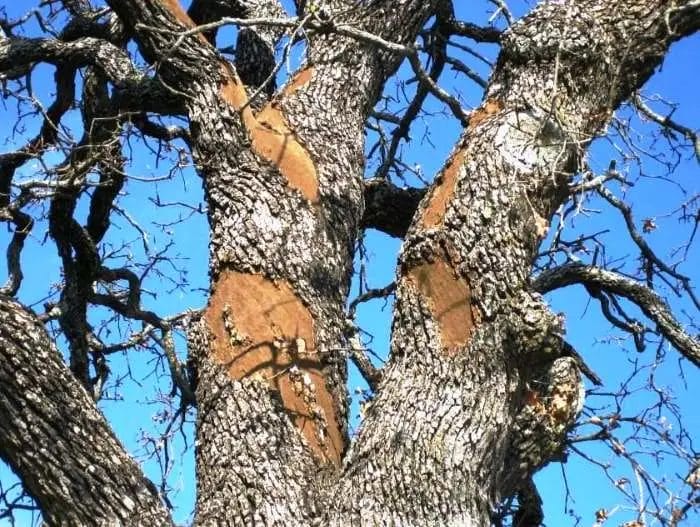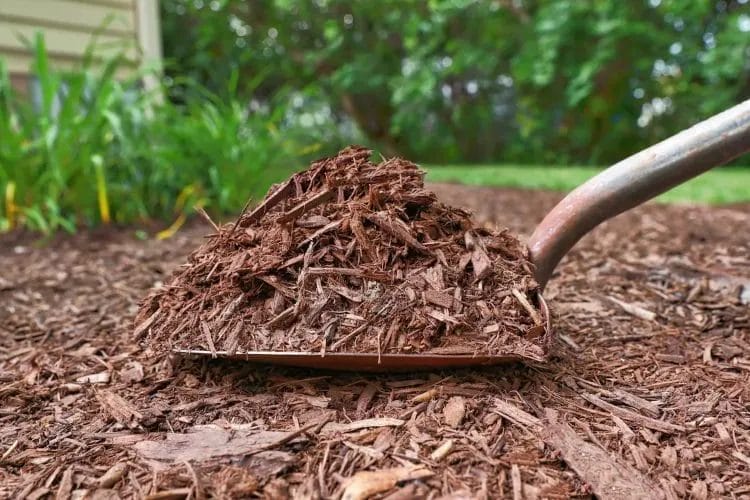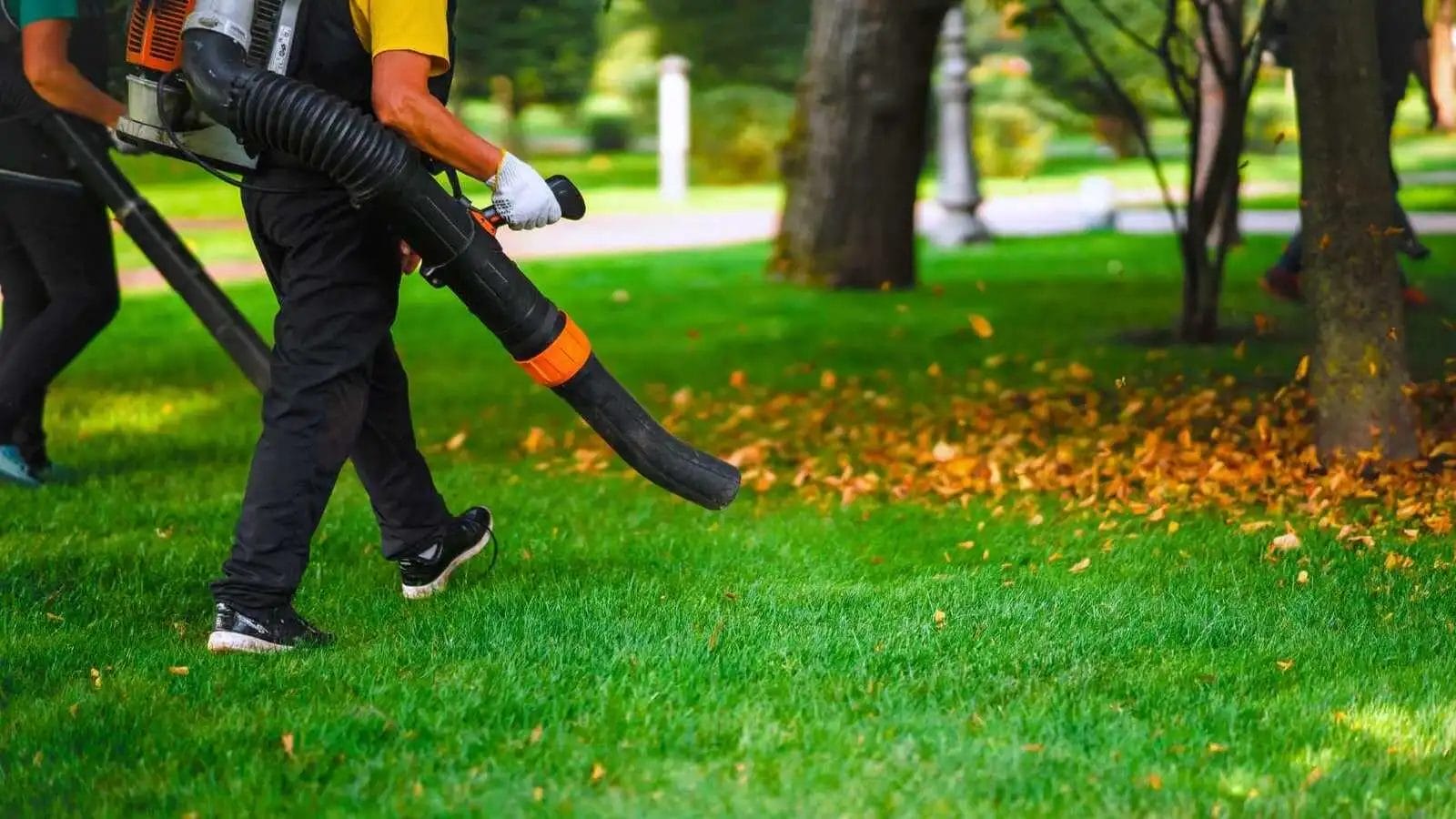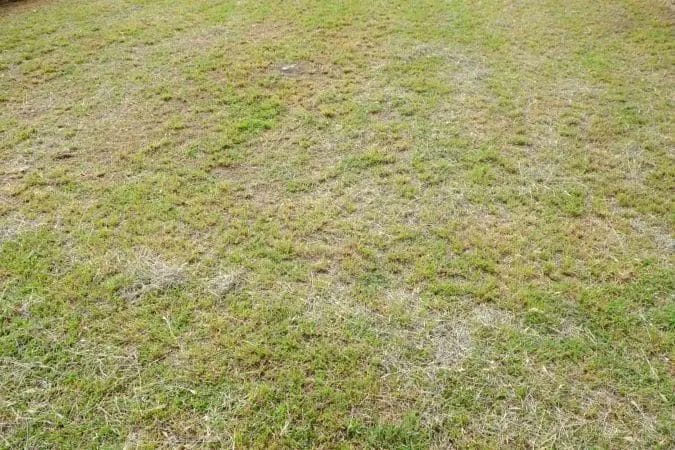
As the scorching summer heat begins to wane, residents can finally breathe a sigh of relief – oak wilt season is officially behind us! This means it’s now safe to tend to your beloved oak trees without risking the spread of this devastating disease. At Smith Brothers Services, our team of expert arborists at Smith Brothers Tree Services understand the importance of proper tree care. With the all-clear given, it’s the perfect time to schedule a trimming with our Smith Landscaping and Smith Brothers Landscaping teams to keep your oaks healthy and thriving. In this post, we’ll guide you through the dos and don’ts of oak tree trimming in the off-season.
What is Oak Wilt?
The fungal pathogen Ceratocystis fagacearum causes oak wilt, a vascular disease that disrupts the tree’s ability to transport water and nutrients. This leads to the characteristic wilting of leaves, discoloration, and eventually, tree death. Oak wilt affects many species of oak, but some, like the live oak and red oak, are more susceptible than others.
Oak wilt is a significant concern, where the disease is prevalent and can spread rapidly. As a responsible tree owner, it’s crucial to recognize the signs of oak wilt and take proactive measures to prevent its spread.
How is Oak Wilt Spread?
Wilt fungi spread through root grafts, which occur when the roots of adjacent oak trees intertwine. This natural process allows the fungus to move from an infected tree to a healthy one, causing new infections. Oak wilt can also be spread by sap-feeding beetles, which pick up the fungus from infected trees and transport it to healthy ones.
In addition, human activities like pruning or wounding oak trees during the active transmission period can facilitate the spread of oak wilt. This is why it’s vital to work with a reputable tree care company like Smith Brothers Landscaping, which follows best management practices to minimize the risk of oak wilt transmission.
What’s more, oak wilt can also be spread through contaminated soil and water. For instance, if an infected tree is removed, the fungus can remain in the soil, posing a risk to nearby healthy trees. Similarly, if infected wood is moved to a new location, it can introduce the fungus to previously unaffected areas. By understanding these transmission pathways, you can take informed steps to protect your oak trees and prevent the spread of oak wilt.
The Risks of Trimming During Oak Wilt Season
Clearly, trimming oak trees during the wrong time of year can have devastating consequences. Oak wilt season, which typically runs from February to June, is a critical period when tree care professionals must exercise extreme caution.
Why Trimming Can Be Harmful
Any unnecessary cutting or pruning during oak wilt season can create open wounds on the tree, providing an entry point for the oak wilt fungus. This fungal disease is highly infectious and can spread quickly through root systems, killing entire stands of oak trees. At Smith Brothers Services, our team of certified arborists understands the risks associated with trimming during oak wilt season and takes every precaution to avoid spreading the disease.
Furthermore, trimming during oak wilt season can also attract beetles that carry the fungus, further increasing the risk of infection. These beetles are drawn to the fresh sap of newly cut branches, making it necessary to avoid any unnecessary pruning during this time. By waiting until the oak wilt season has passed, you can minimize the risk of infection and ensure the health and longevity of your oak trees.
The Importance of Timing
During the winter months, oak trees are dormant, making it an ideal time to prune or trim without risking the spread of oak wilt. At Smith Brothers Landscaping, we recommend scheduling your tree services during this time to ensure the health and safety of your trees. Our team of experts will work with you to develop a customized tree care plan that takes into account the unique needs of your oak trees.
Timing is everything when it comes to oak tree care. By waiting until the oak wilt season has passed, you can rest assured that your trees are safe from the risks associated with trimming during this time. At Smith Brothers Tree Services, we pride ourselves on our commitment to providing top-notch tree care services that prioritize the health and well-being of your trees.
Identifying Oak Wilt Symptoms

After the threat of oak wilt season has passed, it’s imperative to inspect your oak trees for any signs of infection. Oak wilt, a fungal disease, can be devastating to these majestic trees, and early detection is crucial for effective treatment.
Common Signs of Oak Wilt
Any discoloration or yellowing of leaves, particularly in the upper canopy, can be an indication of oak wilt. As the disease progresses, leaves may become wilted, turn brown, or fall off prematurely. Another common sign is the formation of fungal mats, which appear as dark, circular patches on the trunk or branches.
In severe cases, oak wilt can cause significant dieback, leading to the death of entire branches or even the entire tree. Keep in mind that these symptoms can also be caused by other factors, such as drought, pests, or nutrient deficiencies, so it’s imperative to consult with a certified arborist or tree care professional from Smith Brothers Services for an accurate diagnosis.
How to Diagnose Oak Wilt
With the help of a trained expert from Smith Brothers Landscaping, diagnosing oak wilt involves a combination of visual inspections, laboratory testing, and examination of the tree’s history. A thorough inspection of the tree’s foliage, branches, and trunk can reveal signs of infection, such as fungal mats or discoloration.
Another key factor in diagnosing oak wilt is examining the tree’s roots. Oak trees can become infected through root grafts with neighboring trees, so it’s imperative to inspect the root system for any signs of damage or decay. By combining these methods, a certified arborist from Smith Brothers Tree Services can provide an accurate diagnosis and recommend the best course of treatment.
Another important consideration when diagnosing oak wilt is the timing of the symptoms. If you notice signs of infection during the spring or early summer, it’s crucial to act quickly to prevent the disease from spreading further.
Preparing for Safe Trimming
Unlike other seasons, oak wilt season requires extra caution when trimming your oak trees. To ensure the health and safety of your trees, it’s necessary to take the necessary steps before pruning.
Before you start trimming, take a step back and assess your oak trees’ condition. This will help you identify any potential issues and make informed decisions during the trimming process.
Inspecting Your Oak Trees
Preparing your oak trees for trimming begins with a thorough inspection. Walk around your property and examine each oak tree, looking for signs of disease, pests, or damage. Check for cracks, wounds, or cankers on the trunk and branches, as these can provide entry points for oak wilt fungus. Also, inspect the leaves and foliage for signs of stress, such as yellowing, browning, or premature defoliation.
During your inspection, make note of any dead, dying, or damaged branches. These will need to be removed to prevent the spread of disease and encourage healthy growth. Take photos or make a mental note of the areas that require attention, so you can refer to them later during the trimming process.
Removing Infected Branches
Infected branches can be a significant source of oak wilt transmission. Removing them is crucial to preventing the spread of the disease. When removing infected branches, make clean cuts just outside the branch collar, using sanitized pruning tools to prevent the spread of the fungus.
It’s necessary to remove infected branches carefully to avoid spreading the disease to other parts of the tree or nearby trees. If you’re unsure about how to remove infected branches safely, consider consulting with a certified arborist from Smith Brothers Services, experts in tree care and maintenance.
Removing infected branches is not only crucial for preventing the spread of oak wilt, but it also promotes healthy growth and reduces the risk of further damage. By taking this step, you’ll be giving your oak trees the best chance to thrive and remain healthy.
Do not forget, when it comes to tree care, it’s always better to err on the side of caution. If you’re unsure about any aspect of trimming your oak trees, consider consulting with a professional from Smith Brothers Landscaping or Smith Brothers Tree Services. Their expertise will give you peace of mind and ensure the health and beauty of your oak trees.
Best Practices for Trimming Oak Trees

Pruning Techniques for Oak Trees
Pruning is an necessary aspect of oak tree care, as it promotes healthy growth, improves structure, and enhances aesthetics. When pruning oak trees, it’s necessary to make clean cuts, removing any dead, diseased, or damaged branches. This will prevent the spread of disease and encourage healthy growth. Additionally, pruning during the dormant season (winter) can help minimize the risk of oak wilt infection.
It’s also crucial to avoid over-pruning, as this can cause stress to the tree, making it more susceptible to disease and pests. A general rule of thumb is to remove no more than 25% of the tree’s foliage in a single year. By following these guidelines, you can ensure your oak tree remains healthy and thriving.
Tools and Equipment Needed
Practices such as pruning require the right tools and equipment to ensure safe and effective results. Regarding trimming oak trees, you’ll need a combination of hand tools and machinery, depending on the size and location of the tree.
For smaller branches, hand tools like pruning shears, loppers, and hand saws are ideal. For larger branches, you may need to employ the use of pole saws, chainsaws, or even aerial lifts. It’s necessary to choose the right tool for the job to avoid damaging the tree or causing injury to yourself or others.
Needed for any tree trimming project are also personal protective equipment (PPE) such as gloves, safety glasses, and a hard hat. Smith Brothers Services, a reputable tree care company, recommends investing in high-quality equipment and tools to ensure the best possible results. With the right tools and techniques, you can confidently tackle your oak tree trimming project, knowing you’re doing what’s best for your tree’s health and longevity. Contact Smith Brothers Tree Services or Smith Landscaping for professional guidance and assistance.
Post-Trimming Care
Monitoring for Oak Wilt Re-Infection
One of the most critical aspects of post-trimming care is monitoring your oak trees for signs of oak wilt re-infection. Keep a close eye on your trees for any symptoms such as yellowing or browning leaves, premature defoliation, or fungal mats growing on the trunk or branches. If you notice any of these signs, contact a certified arborist from Smith Brothers Tree Services immediately to assess the situation and provide guidance on the best course of action.
Regular monitoring will help you identify any potential issues early on, allowing you to take prompt action to prevent the spread of oak wilt disease. Bear in mind, prevention is key when it comes to protecting your oak trees from this devastating disease.
Maintaining Tree Health
Any tree care professional will tell you that maintaining tree health is an ongoing process that requires regular attention and care. After trimming your oak trees, make sure to water them regularly, especially during periods of drought or extreme heat. A well-hydrated tree is better equipped to fight off diseases and pests, reducing the risk of oak wilt re-infection.
Maintaining tree health also involves providing vital nutrients through fertilization. Smith Brothers Landscaping offers customized fertilization programs designed to meet the specific needs of your oak trees. By providing the necessary nutrients, you can help your trees thrive and reduce their susceptibility to disease.
With regular monitoring and proper care, you can enjoy the beauty and benefits of your oak trees for years to come. By choosing a reputable TREE SERVICES provider like Smith Brothers Tree Services, you can rest assured that your trees are in good hands. Our team of certified arborists is dedicated to providing top-notch tree care services, including trimming, pruning, and fertilization, to keep your oak trees healthy and thriving.
Final Words
Summing up, the oak wilt season may be over, but the importance of responsible tree care practices remains year-round. As we welcome the opportunity to safely trim our oak trees in Central Texas, let’s not forget the crucial role we play in preserving the health and beauty of our natural surroundings. By being mindful of the risks associated with oak wilt and taking proactive measures to prevent its spread, we can ensure the long-term vitality of our trees and the ecosystems they support.
If you’re looking for trusted experts to help you navigate the world of tree care, look no further than Smith Brothers Services, your go-to provider for top-notch Smith Brothers Landscaping, Smith Brothers Tree Services, and Smith Landscaping solutions. With their expertise and guidance, you can rest assured that your trees will receive the care they need to thrive. Keep in mind, responsible tree care is a collective effort, and by working together, we can create a healthier, more sustainable environment for generations to come. Contact Smith Brothers TREE SERVICES today to learn more about their comprehensive tree care services and take the first step towards a greener, more resilient tomorrow.





